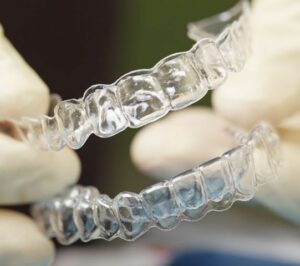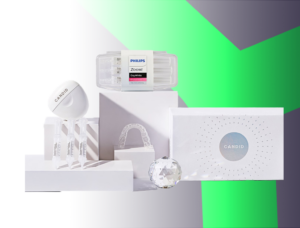
When deciding between braces and aligners for teeth misalignment, there are many factors to consider. Scientific studies are backing the efficacy of both in different aspects, and then cost and convenience come into play. Clear aligners suit those without severe teeth misalignment, offering discretion and comfort. However, braces excel in complex cases and customization.
A study published in the Angle Orthodontist Journal compared aligner therapy and braces to straighten teeth. The findings showed that ALT took less time for appointments and treatment than braces. In this article, we will present a comparison of aligners and braces and explain why we consider aligners to be better among the two choices.
What Are Aligners?
Aligners are a special kind of braces made of clear, almost invisible trays crafted from a sturdy, smooth plastic-like material. They’re custom-designed to fit your teeth perfectly. These aligners gently push your teeth into the right places, gradually fixing crookedness or spacing issues.
Aligners are removable, so eating, brushing, and flossing are a breeze. They’re comfortable to wear, though your teeth might feel a bit sensitive when you start. But do aligners work? This is an often question as they are relatively new inventions compared to conventional metal braces. It’s a fact that they work wonders for mild-to-moderate teeth alignment troubles without the need for extreme changes.
Traditional braces might be better for more complex issues, like significant misalignments or severe overbites. However, some aligners, like Invisalign, can handle mild to moderate overbites well.
Having first-hand experience of using aligners for overbite correction, I can imagine the initial awkwardness of a foreign object nudging your teeth. However, what follows this slight discomfort is a gradual sense of satisfaction as your smile subtly transforms day by day.
Pros and Cons of Using An Aligner
Pros
- Aligners are virtually invisible, so you can still smile confidently while wearing them. No metal, no hassle, just a beautiful transformation in progress.
- You can pop out the aligners for any meal or drink, then pop them back in for effortless straightening.
Cons
- Wearing aligners 22 hours a day requires commitment, but the reward is a dazzling smile you can flaunt freely.
Types of Aligners
Understanding the key types of aligners can guide you toward your perfect smile.
-
Clear Aligners
These removable trays, made from medical-grade plastics, subtly nudge your teeth into place. Clear aligners offer discreetness and comfort with virtually no metal or wires.
-
Traditional Aligners
Traditional aligners are crafted by orthodontists using intricate impressions. This personalized approach ensures faster results and improved comfort. Traditional aligners may require more frequent adjustments and come with a higher price tag.
-
Custom Aligners
The middle ground between in-office and at-home options, custom aligners provide more control than over-the-counter solutions while offering some DIY convenience. You can either get fitted by your dentist or use an at-home kit tailored to your unique dental map.
-
Over-the-Counter Aligners
Pre-made over-the-counter aligners might be budget-friendly, but they lack the personalized touch of other options. They may not fit perfectly, potentially increasing treatment time and compromising effectiveness.
There are several brands of dental aligners, making one confused about which one to go for. Although AlignerCo and Candid make a place in our recommendations, Byte wins the race in all aspects to grab the top spot among dental aligners. Delve deeper into Byte’s magic through our roundup of Byte reviews for a comprehensive understanding.



Remember, proper oral hygiene and tongue placement practices like Mewing can work in tandem with any aligner type to boost your orthodontic journey. Learn more about Mewing with Invisalign in our in-depth analysis.
What Are Braces?
Braces are made of metal wires that gently guiding your teeth to their ideal positions. Metal brackets bonded to each tooth act as anchors and thin wires threaded through them serve as tracks. Over time, gentle tightening of the wires applies pressure, coaxing your teeth into straighter smiles.
You might experience an initial adjustment period with some slight discomfort or sensitivity with braces. They effectively tackle orthodontic issues like crooked teeth, gaps, overcrowding, and even bite misalignment. Regular brushing, flossing, and check-ups are crucial to keep braces in tip-top shape.
If you want an alternative for straightening teeth without braces, you can explore techniques like mewing, aligners, or retainers.
Pros and Cons of Using Braces
Pros
- Braces tackle gaps, overcrowding, and bite issues, paving the way for a confident smile.
- Unlike temporary fixes, braces offer permanent improvements to your dental alignment.
- Braces can change your jaw significantly.
Cons
- Prepare yourself for regular maintenance. Cleaning, flossing, and frequent consultation with your orthodontist are essential to keep braces in good shape.
- Recovering your jaw after braces might not be easy.
Types of Braces
When it comes to straightening smiles, braces aren’t one-size-fits-all.
- Metal Braces: The classic metal braces are affordable and effective. The sturdy brackets and wires guide your teeth to their perfect positions.
- Ceramic Braces: Ceramic braces offer a discreet alternative. These tooth-colored brackets blend seamlessly, letting your beautiful smile take center stage.
- Lingual Braces: For ultimate invisibility, lingual braces hide behind your teeth! While requiring a bit more adjustment, they’re perfect for keeping your smile transformation under wraps.
- Self-Ligating Braces: These innovative braces ditch the elastic ties, using clips or doors to hold the wires. They require fewer adjustments and smoother progress.
- Clear Aligners: While technically a subtype of braces, aligners deserve a special mention. These removable trays offer invisible, gradual tooth movement, perfect for those seeking a convenient and discreet option.
If you wear braces and are involved in an impact-prone activity, you can wear a specially fitted mouthguard with braces and aligners.
Are Aligners Better Than Braces?
Both aligners and braces work well to straighten teeth and are the most commonly recommended orthodontics tools. A holistic approach, considering several factors, paints a clearer picture.
Aligners are incredibly helpful for individuals seeking discreet, comfortable orthodontic treatment. Aligners are more discreet than braces. Plus, their convenience, and allowing for removal during meals and cleaning stand are the key advantages. Aligners potentially offer shorter treatment durations. However, the patient must comply with the recommended 22-hour wear.
On the other hand, braces can handle complex dental cases with high effectiveness, delivering predictable and enduring outcomes. Their fixed nature ensures continuous treatment. Yet, their visibility, occasional discomfort during adjustments, and dietary restrictions are significant drawbacks.
Extensive research into the scientific literature on braces versus aligners reveals aligners as a superior choice for various mild-to-moderate dental alignment needs. However, consulting an orthodontist for a personalized evaluation is crucial, considering factors such as the severity of misalignment and budget constraints to determine the most suitable treatment approach.
Clear Aligners vs Braces: Comfort
Aligners outshine braces in comfort. They’re like invisible shields, gently adjusting teeth without the discomfort of metal and wires. While aligners may bring slight pressure initially, it’s a breeze compared to braces’ constant discomfort.
Removable aligners offer freedom—presenting confidently or savoring meals without restriction. Some patients might find the snugness of aligners a bit claustrophobic, while some don’t feel comfortable with the metal brackets of braces constantly nudging their tongue and cheeks. Comfort varies, so choosing the best clear aligners and consulting an orthodontist for a personalized fit is key.
Aligners vs Braces: Esthetics
Clear aligners are plastic replicas of your teeth, stealing the show when it comes to aesthetics. These nearly invisible trays quietly guide teeth toward alignment, fixing issues such as overbite without the metal glare of braces. Along with the clear aligners, you can also try techniques such as mewing to fix an overbite and improve your face symmetry for aesthetic purposes.
Braces vs Aligners: Efficiency Comparison
The efficiency battle of aligners vs braces boils down to the patients and the challenges they face. Using braces is one of the best ways to fix an open bite, underbite, or severe crowding cases. Getting the desired outcomes with braces can take around 18-24 months.
On the other hand, Aligners are great at fixing mild to moderate misaligned teeth, including bite issues, crowding, or spacing. They resolve the issues with gentle force and flexibility in 12-18 months, which makes them a suitable choice for a quicker approach.
Aligners vs Braces Cost Comparison
Aligners and braces differ in cost, influenced by various factors. Braces, averaging $1800 to $5500, come with fixed pricing regardless of complexity. Aligners, ranging from $3,000 to $5,000, might have added costs for complexity adjustments or replacements. Factors like treatment duration and additional components impact the final expense.
| Aligners | Braces | |
| Cost Range | $3000 – $5000 | $1800 – $5500 |
| Comfort Level | Comfortable and gentle | Causes discomfort |
| Aesthetics | Invisible | Metal wires visible |
| Efficiency | Great for mild to moderate orthodontic cases | Good at handling severe orthodontic issues |
Understanding the differences between braces and aligners helps in making a more informed decision tailored to individual patients’ needs.
Aligners or Braces: When To Consult a Doctor?
Before choosing between braces vs aligners, it is ideal to contact an orthodontist. Aligners, known for comfort and invisibility, suit many but may not address all issues, while braces are versatile and suitable for complex ones. An orthodontist evaluates the severity of your misalignment and other coexisting issues, crafting the best treatment plan for individual cases.
Conclusion: Which is Better Braces or Aligners?
The choice between braces or aligners hinges on individual needs, such as the severity of the issue, budget, and time constraints. Aligners excel for mild-to-moderate issues, offering comfort and discretion. Braces excel in treating complex cases but are visible and occasionally uncomfortable. Consulting an orthodontist determines the better fit based on specific dental requirements.



